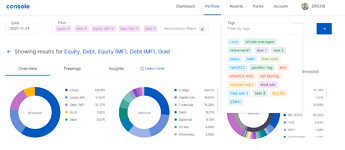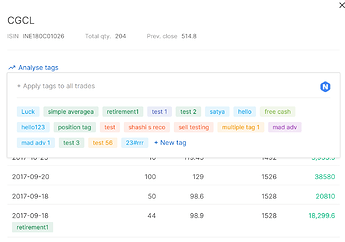Answered here
I blew up everything on a long option trade, including borrowed money. Went to a call centre and had to work for 3.5 years to recover (2002 to 2006). This trying to make quick money is what attracts most to markets and also the reason most people lose money.
Yeah, on our list of things to do. This one has taken time since it needs some regulatory approvals.
It depends on case to case. We would typically put up an explainer on our Bulletin.
Btw your example, if stock went from 100 to 50, the lot size on the ex date will double to cover for the split. Makes no difference to your position.
If the market moves in your favor, you make money, otherwise you lose money. Typically broker risk management systems will square off positions if you don’t have sufficient capital to hold a position after a loss. But assuming there is no liquidity in the markets and hence broker RMS can’t exit, you will be forced to hold the position till expiry or until you can exit. Losses will be on your head.
Check out modules 4, 5, & 6
While there are a lot of speculators who trade derivatives, there are also hedgers who reduce the risk by using derivatives and arbitrageurs who ensure better price discovery. Derivatives also indirectly provide a lot of liquidity to the underlying stock markets.
Hello team!
I’m a total noob when it comes to the stock market. Trying to understand the inherent value of stocks.
What is the team’s view on the value of non-dividend paying stocks. Isn’t the returns paid via dividends is what made the stocks valuable? Today when most companies aren’t paying significant dividends what makes the stock valuable? This is also the primary argument in the book The Ponzi factor. https://theponzifactor.com/
Would love to hear the team’s thoughts / perspective on this.
Thank you.
Intrinsic value of options?
when is Zerodha mutual fund
If there was a best, everyone would use it and soon there wouldn’t be a best. ![]() But jokes apart, I don’t really think you can copy-paste someone else’s technical analysis strategy. You need to figure what works best for you.
But jokes apart, I don’t really think you can copy-paste someone else’s technical analysis strategy. You need to figure what works best for you.
Maybe @Karthik can help with a good starting point?
Thankfully I don’t invest in public markets anymore. @nik does all of it.
The only investments I do are for
Investments that can help expand the capital market ecosystem in India and help people do better with their money.
Investments in organizations that are working for the environment and conservation.
All investments here thankfully are done with an idea of impact and not with any money returns in mind. So I have no pressure to generate % returns. ![]()
I can’t comment on RARE, but usually it is when people start managing other people’s money. That is when they branch out into investing through funds, companies, etc. Otherwise yes, it doesn’t make sense due to higher taxes.
Btw I had written this sometime back, check this
Answered above
On console holdings page, you can already filter by tags and track returns right?
Also when you are tagging trades, you can tag the entire breakdown to same tag with just one click.
If you are asking for a custom breakdown of the same stock holding into two different tags, that is a large technological problem for us. By custom I mean, if you have 100 shares of CGCL and you want to say 50 is Long term, 50 is Short term, that isn’t possible. You can only tag actual individual trades to a tag.
For others who want to check out on tagging
Thanks for the reply Nithin… Yes it is the price that drives the indicator and not the other way…
could have rephrased it as better…Anyways I could say I got a reply from zerodha CEO… 
I set up a stoploss and it got hit. Subsequently, the stock modestly increased in value and remained stable at that price for a few days. Is it a good idea to reinvest? i.e. What is the purpose of putting a stop-loss? Is it to prevent huge losses, or is it to indicate that it is time to step away from this scrip?
Agree. All indicators have been someone else’s ‘Trading Systems’, in the past, which is now in the public domain fully juiced out.
Having said that, I personally like the moving average indicator and systems based on the moving averages, as these are simple and easy to understand.
Apart from the moving averages, I also like Bollinger bands and the ATRs as these help in understanding the volatility of a stock/index and identifying trades based on volatility.
The idea behind a stop-loss is to not let losses of one of your trades get so big that it causes a significant drawdown in your overall portfolio.
The more efficient way is to trade with much lesser value. So when you are buying a stock, allocate only a small % of your overall portfolio to that trade. By doing this you can avoid putting a tight stoploss in place. The issue with markets is that they are hardly ever trending one direction, it is usually up and down even when they are trending one way. A tight stoploss means you keep getting chopped out.
If you put say more than 25% of your capital in one trade, you will be forced to put a tight stop as losses will mean a significant dent to your overall trading capital. This idea of tight stop-loss is usually peddled by tipsters to cover their ass when they are wrong. So that they can somehow prove that their tips overall made money. If you have really tight stops it is very tough to make money trading the markets.
How do you know if you have a tight stop?
If you are getting stopped out quite often, that means it is a tight stop.
About getting into the same stock after a stop has been hit. Yes, you can if your trading strategy asks you to. But don’t it for revenge and wanting to recover the money you have lost on that stock. Those trades hardly ever workout okay.
There are multiple factors that drive the value of stocks. The dividend is one factor through which you can identify the value of a stock and you can do this via a special valuation technique called the 'Dividend discount model’.
It’s called a special technique because it’s a subset of a generic valuation technique called the ‘Discounted cash flow model’ or the DCF.
The fact that a company is considered valuable only if it pays dividend is flawed.
To help you understand better, I’ve put a mini QnA -
-
What is a dividend?
A dividend is a cash reward that the company pays to its investors. -
Is it mandatory for a company to pay dividends?
Not mandatory. If the company has money, it can choose to pay dividends. If they don’t, then they obviously won’t. -
What if the company has funds, do they have to pay dividends?
Not really. One of the core responsibilities of a company is also to maximise the shareholder’s wealth. Wealth can be maximized when the company invest in itself prudently (could buy new machinery, build a new plant, expand to new geography). So when the company has cash in hand, they have to decide to either invest in themselves for better growth or if they see no growth opportunities, then they are better off paying dividends.
So as you see there are many valid reasons for not paying dividends, so you cant judge a company’s value based on its dividend policy.

